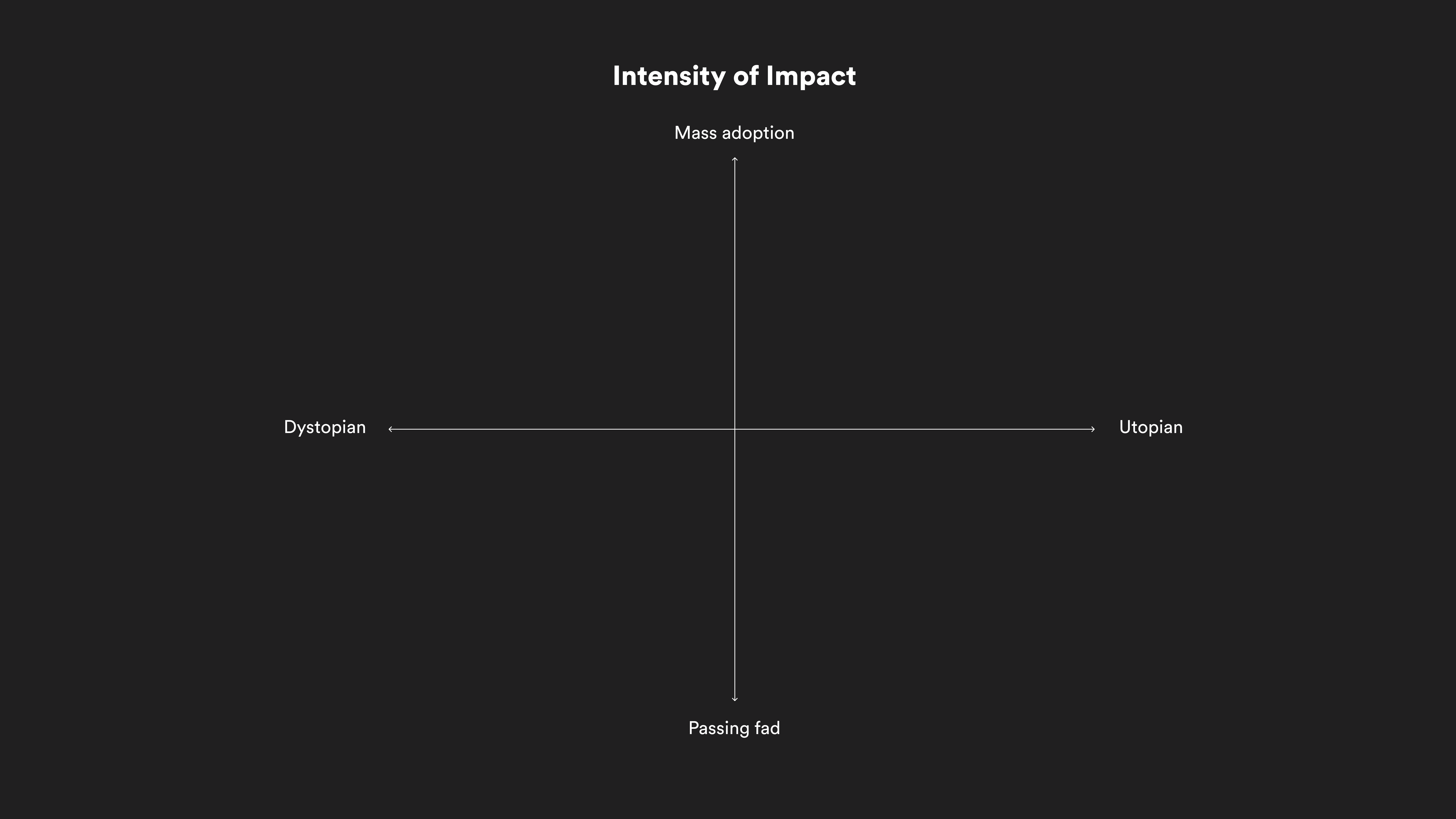Perspectives
What if the metaverse succeeds? A framework to create future realities we might actually want.

“Before long, billions of people around the world were working and playing in the OASIS every day. Some of them met, fell in love, and got married without ever setting foot on the same continent. The lines of distinction between a person’s real identity and that of their avatar began to blur. It was the dawn of new era, one where most of the human race now spent all of their free time inside a videogame.”
—Ernest Cline, Ready Player One
Ernest Cline, in his Ready Player One (and Two) books, paints a picture of a world where everyone avoids the problems of physical reality—a global energy crisis, environmental degradation, extreme socioeconomic inequality—by taking “an escape hatch into a better reality.” That escape hatch is the OASIS, the fully fledged metaverse in virtual reality, “where anything was possible.”
While news cycles have shifted away from the metaverse in recent months (thanks ChatGPT!), big tech and startups have been working diligently behind the scenes, investing billions of dollars in creating alternative realities, with goals of bringing about their own concepts of the metaverse. Apple is heavily rumored to release its mixed reality headset at WWDC in June that will likely challenge the criticisms of Meta’s approach and advance the metaverse’s arrival massively even if under a different label, like spatial computing. With different visions of the metaverse rising up in tandem, we must examine the tools we have access to and the foundation on which we can build in order to ensure this “better reality” is truly better.
Re-define viable
Those in new product development usually think about whether an idea is technologically feasible, desirable to users, and viable in the marketplace.
Meta, Google, Microsoft and Apple, and many other players, like Magic Leap, have been working on Augmented Reality (AR) (e.g., Ray-Ban Stories, Google Glass, Project Starline, iOS), Mixed Reality (MR) (e.g., HoloLens 2, Magic Leap 2, Rumored Apple Headset), and Virtual Reality (VR) (e.g., Meta Quest 2, QuestPro) projects for decades. Advancements in headsets and computing suggest the technology is mature enough to support conceptual reality experience for the mass market. Feasibility: check.
The lukewarm success of remote work has catalyzed a clear problem space for the metaverse to tackle, and our increasing entanglement with contextual online avatars (e.g., vTubers , “finsta” Instagram profiles, and even the everyday Apple Memoji) along with the success of MMO’s (massively multiplayer online games, e.g., Fortnite and Roblox) signal a readiness for consumers to develop a personal connection to an online self and peers, making the metaverse desirable from a consumer standpoint. Desirability: check.
Viability, however, is complicated. Today’s virtual business model relies heavily on advertising. Users experience it as free, but the model has far-reaching direct and indirect consequences. It has helped to harvest and push mass amounts of rare materials into landfills. It has escalated extreme polarization in our political systems and degraded community relationships needed to sustain a democracy. It has sowed distrust of institutions through the proliferation of misinformation. It has fostered screen addiction, and increased social isolation, while weakening interpersonal connections. We’ve learned we can create a viable world — one that is economically profitable for a select few — but, we haven’t learned to create a world viable enough to sustain our environment, political systems, societal values, meaningful relationships, individual agency, and be economically profitable. Viability is there, but it’s complicated. We need to treat it with special care.
If we don’t act now, the metaverse will be built on the same foundation as today’s paradigm of which we’re living the consequences of already.
Here’s a five-step framework you can use to work toward a better metaverse sooner, than later.

Five steps to work toward a better metaverse
As product owners, designers, and technologists, now is the time to ask ourselves, “What if the metaverse succeeds?” As you build the metaverse from your own perspective and strategy, how can you avoid contributing to a world that has the need for an “escape hatch from reality” and create a world we might actually want to spend some time in?
The five steps
Define the term
Plot a path
Map the landscape
Imagine divergent futures
Reflect on strategy

Step one
Define the term
Each company working in mixed reality will define the metaverse differently. Apple will undoubtedly have a different approach from Meta, from Epic, and so on. As it is still emerging, the metaverse currently has no one definition. As such, teams must align on a shared definition to ensure they are working toward the same product vision and forecast the resulting unintended consequences of that strategy.
This framework uses my emerging definition of the metaverse: “a shadow layer creating a seamless experience across shared realities (AR, VR, PR).” This shadow layer would be made up of data and information presented seamlessly and contextually across different realities. There are endless ways the mixing of these realities could be imagined. For example, on an individual scale, imagine a friend in the virtual world that could seamlessly accompany you to dinner in physical reality through an augmented reality experience. Your definition of the metaverse will work for this process too, but it must be clearly defined.

Step two
Plot a path
When defining a better metaverse, you must think critically about the underlying model it would be built on. Consider how your proposal for the metaverse will exist on a spectrum of disruption. Will it augment the existing status quo of today’s centralized model (built on a small number of operating systems and shrinking number of server providers) or push to reimagine an alternative future, such as a decentralized (e.g., Web3) or distributed model (e.g., early internet)? Depending on the model, the landscape and potential futures you’re working toward (and their unintended consequences) will be considerably different.

Step three
Map the landscape
If you look at as many aspects and stakeholders of systems that are a part of the metaverse, you can consider how to shape a better future. Beyond the software to make the metaverse real, you need to step back and consider how it will impact multiple levels of the systems it will operate in. One model (based on, but different from Pace Layering) imagines what the potential effects might be at differing levels of scales (individual, relational, group, societal, environmental, etc.).

After considering the rings of impact, create a matrix by industry (education, healthcare, social impact, etc.) to capture relevant areas the intervention might impact. It’s important to push beyond the obvious stakeholders and industries you might initially consider. Try pushing to include a specific population or industry that isn’t already a part of your normal processes or strategy. These are where we can often see threads of potential unintended consequences emerge.

Step four
Imagine potential futures
While all of the topics and stakeholders captured in the matrix will be affected in some ways, not all will be to the same degree. It may depend on how any given future plays out. Utilize a series of 2×2 future matrices inspired by Alun Rhydderch’s 2×2 Matrix Technique to push hypothetical scenarios that are both idealistic (utopic) and problematic (dystopic), to varying degrees of intensity (mass adoption vs. passing fad). While the future will likely end up somewhere in the middle, considering extremes allows us to hypothesize what the preferable future is and capture potential blindspots where unintended consequences could happen along the way.
Step five
Reflect on strategy
Now reflect on the learnings from the process. Ask yourself several questions. How does your definition and strategy for the metaverse affect society, industries, and individuals? How does your strategy for the metaverse, played out through potential future scenarios, affect the different systems of scale? How might you change your definition, vision, and/or strategy to build toward a better metaverse?

Repeat to keep the stars aligned as the future unfolds.
These 5 steps, from definition to imagining to reflection, must be an ongoing activity; revisited and repeated on a regular basis. The future is uncertain and the world will change around us. Advances in generative A.I. could dramatically change the technological landscape. Changes in political winds could change the governance landscape. A major climate or global health crises, as we saw with COVID-19, could change societal priorities. Doing these activities proactively in the initial design can help reduce the number of reactive outcomes we will have to chase down once the product is released.
Whatever the metaverse becomes, hopefully we all can help make sure it aligns a preferable future that favors all realities; a future world we want to run towards, rather than escape from.
Thank you to Carolyn Yip for helping bring these figures to life through animation, and to Matthew Jordan, Hannah Grace Martin, Neeti Sanyal, Yuna Shin, and Holger Kuehnle for editing and thoughts along the way.
Read Next:
